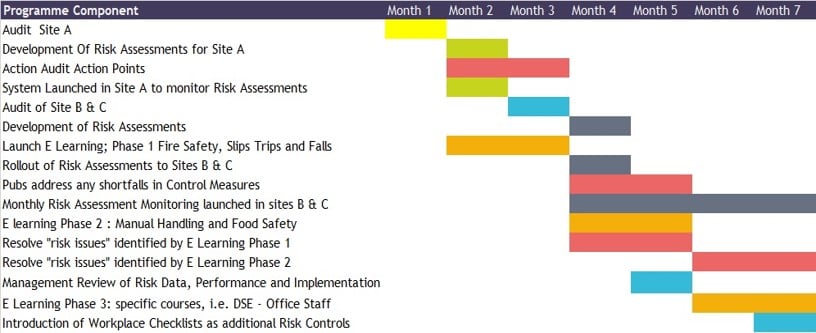The points below are key considerations to achieve a successful implementation.
What do you want to address?
Are you just looking to streamline process and improve controls or are there wider issues around engagement within the business? If you are looking to tackle cultural issues within the business, this might be an important consideration in both the implementation and choice of supplier who can assist you with this.
A SaaS (Software as a Service) solution supplier won’t necessarily be able to assist you with the people issues, engaging your team will be a big factor in successful implementation.
5 Wishes
We ask clients if money were no object what would they change tomorrow regarding the management of Health & Safety in the organisation? This helps us understand what your ideal solution looks like and so we can help you address these. Common goals include:
- Reporting and visibility of activity
- Accountability of tasks
- Claims defensibility
- Staff engagement
- Ease of administration
Understand the impact
The best systems in the world will have minimal benefit if they are not implemented correctly. The key here is to understand the current processes and documentation, and implement new systems at a pace the business can tolerate.
Who are the personalities involved?
A new system means change and different personality types react differently to change. Those who tend to gravitate to risk management roles are often those personality types that are less comfortable with change and have a need to do things properly; the implementation plan needs to ensure they feel comfortable and are supportive of the process.
What training and support will be needed?
This is both for those who will run the system and those who will engage with it, for example supervisors. A critical part of the implementation process and it goes beyond initial orientation training and documentation (we use bespoke crib sheets) is the support through the initial weeks of the system. We consider this to be one of the most important elements of the implementation.
Getting the system to reflect the business
If one of your drivers for the system is to create alignment between Health & Safety and the business, having a system that replicates the businesses organisational structure including the appropriate segregation of data, will be an important factor to generate performance data that drives accountability and visibility throughout the organisation.
Management information
Requirements will differ, but if you are looking to blend a safety and performance culture this can be important.
Different systems will deliver varying levels of data, from simple task management information to compliance performance data (e.g. this month you comply with 95% of the control measures in your risk assessments) and even data generated by employees about their own working environment (we do this via E-Learning). MI will support the development of Safety KPI’s.
Mapping your existing documentation and controls
If you have a system that “works” then this is an important step to avoid any downtime which can lead to a loss of focus on safety management in the business.
It’s important to understand how current documentation will map across to a new system, what the priorities are and also what support is available from the supplier to work with you on this. These can then be factored into your game plan.
Formulate a game plan
The key to this is bite-sized chunks. Any new system should be embedded in the business with minimal impact to business-as-usual operations. Once you have a good idea of what the implementation process will involve, it is time to make the implementation work for you. Collaborate with the software provider to develop a step-by-step plan for implementation. Make sure the systems providers understand your company’s needs and what you hope to accomplish.

If you would like further information, contact us on 0800 879 9981 or email info@bcarm.co.uk
